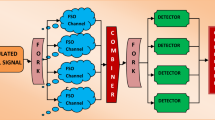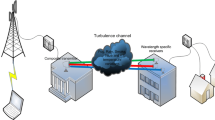Abstract
In an optical like free space optical communication system, there always exits a focal or focal reflective optical antenna system working as beam expander. As optical antenna can expand and reshape the narrow and highly collimated emitted beam, it efficiently compresses divergence angle and decreases the influence of beam expansion in space optical communication. However, the optical antenna structure will decrease the transmission power for the obscuration loss caused by the secondary reflective mirror. The design of two-mirror reflective optical antenna at Tx affects the transmission efficiency in space uplink optical communication. An improved scheme with two diffractive optical elements (DOEs) can help reduce central obscuration caused by the secondary mirror of optical antenna. In order to further investigate the influence of the DOEs on communication quality, we give a bit error rate (BER) model based on space uplink optical communication system. The effect of the DOEs on the relationship curves of BER versus typical parameters at different obscuration ratios of optical antenna is the research focus. Typical system parameters include transmission power, receiving diameter, Receiver angle, divergence angle and wavelength. With the demand for data volume and data velocity growing, space optical communication has gained extensive attention. It originated in the 1960s and a large number of ground verification experiments have been carried out since 1980. Compared with traditional microwave communication, space optical communication has the advantages of small volume, low power consumption, large optical gain, and small divergence angle, strong anti-jamming and anti-interception ability.




Similar content being viewed by others
References
S. Chaudhary, A. Amphawan, K. Nisar, Realization of free space optics with OFDM under atmospheric turbulence. International Journal for Light and Electron Optics 125(18), 5196–5198 (2014)
Sridhara K, “ free space optical communication” International Journal of Latest Research in Science andTechnology, 1, 3, September-October (2014), 202–205, ISSN (Online):2278–5299.
J. He, R.A. Norwood, M. Brandt-Pearce, I.B. Djordjevic, M. Cvijetic, S. Subramaniam, R. Himmelhuber, C. Reynolds, P. Blanche, B. Lynn, N. Peyghambarian, A survey recent advances in optical communications. Journal of Computers & Electrical Engineering 40(1), 216–240 (2014)
Debashish Sahoo, Naresh Kumar, D.R. Rana, “Enhanced performance analysis of optical CDMA communication system” International Journal for Light and Electron Optics, 125, 14, July 2014, 3619–3622.
N. Kumar, T. Singh, 2.50 Gbit/s optical CDMA over FSO communication system. International Journal for Light and Electron Optics 125(16), 4538–4542 (2014)
L.I. Yi-bing, Z. Xu, Y.E. Fang, G.A.O. Zhen-guo, Improved proportional fair dynamic subcarrier allocation with frugality constraint for SC-FDMA system. The Journal of China Universities of Posts and Telecommunications 20(2), 54–59 (2013)
R.K.Z. Sahbudin, M. Kamarulzaman, S. Hitam, M. Mokhtar, S.B.A. Anas, Performance of SAC OCDMA-FSO communication systems. Optik - International Journal for Light and Electron Optics 124(17), 2868–2870 (2013)
Robert J. Becerra, “What Are the Effects of Weather on Laser Communications” california state science Fair, April 2/2006, Project Number J0703.
Mazin Ali Abd Ali and Miami Abdulatteef Mohammed, “Effect of Atmospheric Attenuation on Laser Communications for Visible and Infrared Wavelengths” Journal of Al-Nahrain University, Vol.16 (3), September, 2013, 133–140.
Mazin Ali A. Ali, “Analysis of Data Rate for Free Space Optical Communications System” International Journal of Electronics & Communication Technology (IJECT), Vol. 5, Spl-1, Jan - March 2014, 20 – 23, ISSN : 2230–7109 (Online) | ISSN : 2230–9543 (Print).
M.A.A. Ali, Free space lasers propagation at different weather conditions. Al Mustansiriyah J. Sci 23(2), 81–90 (2012)
Amit Yadav, Priyanka Yadav, Anchal “Effect of Environmental Factors on Free Space Propagation of Mid Infrared Quantum Cascade Laser” International conference on Advanced Computing, Communication and Networks’11, 1082, 1082–1086.
Maha Achour, “Free-Space Optics Wavelength Selection: 10 μ Versus Shorter Wavelengths” UlmTech , Inc., 1–15.
Zhang Yu-mei, XIN Yu, YANG Da-cheng, “Multiuser subcarriers and bit allocation combining adaptive mapping for SC-FDMA system” The Journal of China Universities of Posts and Telecommunications, 15, 3, September 2008, 41–46.
F. feza büyükşahin öncel, “Modulation Formats for Wavelength Division Multiplexing (WDM) Systems”. Thesis . The Graduate School of Natural and Applied Sciences of Middle East Technical University , September 2009, 1–159.
Hilal A. Fadhil, Angela Amphawan, Hasrul A.B. Shamsuddin, Thanaa Hussein Abd, Hamza M.R. Al-Khafaji, S.A. Aljunid, Nasim Ahmed, “Optimization of free space optics parameters: An optimum solution for bad
weather conditions” Optik - International Journal for Light and Electron Optics, 124, 19, October 2013, 3969–3973.
S.A. Al-Gailani, A.B. Mohammad, R.Q. Shaddad, Enhancement of free space optical link in heavy rain attenuation using multiple beam concept. Optik - International Journal for Light and Electron Optics 124(21), 4798–4801 (2013)
Vishal Sharma, Sushank, “High speed CO-OFDM-FSO transmission system” Optik - International Journal for Light and Electron Optics, 125, 6, March 2014, 1761–1763.
Samir A. Al-Gailani, Abu Bakar Mohammad, Usman U. Sheikh, Redhwan Q. Shaddad, “ Determination of rain attenuation parameters for free space optical link in tropical rain” Optik - International Journal for Light and Electron Optics, 125, 4, February 2014, 1575–1578.
Arun Gangwar, Manushree Bhardwaj, “An Overview: Peak to Average Power Ratio in OFDM system & its Effect” International Journal of Communication and Computer Technologies, 01 – No.2, : 02 , September 2012, 22 – 25, ISSN : 2278–9723.
Paramdeep Singh, Maninder Lal Singh, “Experimental determination and comparison of rain attenuation in free space optic link operating at 532 nm and 655 nm wavelength” Optik - International Journal for Light and Electron Optics, 125, 17, September 2014, 4599–4602.
Mazin Ali A. Ali, “Atmospheric Turbulence Effect on Free Space Optical Communications” International Journal of Emerging Technologies in Computational and Applied Sciences (IJETCAS), 2013, 345–351, ISSN (Print): 2279–0047, ISSN (Online): 2279–0055.
A. Nain, S. Kumar, S. Singla, Mitigation of FWM induced crosstalk in WDM RoF systems by employing different fibers. J. Opt. 46, 492–498 (2017)
A. Nain, S. Kumar, S. Singla, Impact of XPM Crosstalk on SCM-Based RoF Systems. J. Opt. Commun. (2016). https://doi.org/10.1515/joc-2016-0045
K. Kazaura, K. Wakamori, M. Matsumoto, T. Higashino, K.Tsukamoto and S. Komaki, "RoFSO: A universal platform for convergence of fiber and free-space optical communication networks," Communications Magazine, IEEE, vol. 48, pp. 130–137(2010).
J.C. Juarez, A. AnuragDwivedi, R. Hammons, Jr., Steven D. Jones, VijithaWeerackody, and Robert A. Nichols, , Free-space optical communications for next-generation military networks. IEEE Commun. Mag. (2006). https://doi.org/10.1109/MCOM.2006.248164
A.Mansour, R.Mesleh, M.Abaza, “New challenges in wireless and free space optical communications”, Optics and Lasers in Engineering (2016).
H.E. Nistazakis, T.A. Tsiftis, G.S. Tombras, Performance analysis of free-space optical communication systems over atmospheric turbulence channels. IET Commun. 3(17), 1402–1409 (2009)
Author information
Authors and Affiliations
Corresponding author
Additional information
Publisher's Note
Springer Nature remains neutral with regard to jurisdictional claims in published maps and institutional affiliations.
Rights and permissions
About this article
Cite this article
Soni, G., Gupta, S. & Vaish, A. Performance investigation of diffractive optical elements effect and rain attenuation on BER of an optical free space communication based system. J Opt 50, 606–610 (2021). https://doi.org/10.1007/s12596-021-00720-z
Received:
Accepted:
Published:
Issue Date:
DOI: https://doi.org/10.1007/s12596-021-00720-z




